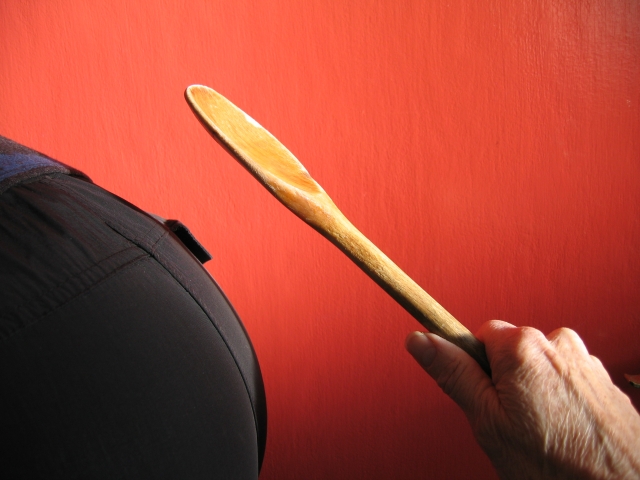Section 43 of the Criminal Code and our Children; a Complex Issue
Contemplating two forms of violence: physical and emotional
Have you ever spanked or swatted your child (or been tempted to)? Were you ever spanked (or worse) as a child? In Canada, S. 43 of the Criminal Code protects the right of a parent or teacher to use “force by way of correction”. That section is commonly known as “the spanking law” (though it encompasses much more than spanking — such as forcible restraint of a child who is hurting another, as one example) and this is what it says:
“43. Every schoolteacher, parent or person standing in the place of a parent is justified in using force by way of correction toward a pupil or child, as the case may be, who is under his care, if the force does not exceed what is reasonable under the circumstances.”
Some people want the government to repeal S. 43. Recently, a petition has been making the rounds.
Kathy Lynn, a parenting speaker and lifelong advocate for ending physical punishment of children, points out that at various times in our history, Canadian laws have sanctioned hitting slaves, apprentices, prisoners, dogs, wives and children. “Today in Canada, children are the only group left on that list. It is a breach of both their right to security and to equality to have Section 43 still providing a legal defence for the use of force to ‘correct’ children’s behavior.”
She said in addition to the repeal of Section 43, her campaign — “Corinne’s Quest”— also intends to support education for families and parents about the many progressive and effective non-violent ways to raise their children to be responsible self-disciplined adults.
In 2004, the Supreme Court of Canada (SCC) heard a case that challenged the constitutionality of S. 43. The Canadian Foundation for Children, Youth and the Law sued the Attorney General of Canada, arguing that S. 43 is unconstitutional. The majority judgment of the SCC held that section 43 does not violate a child’s rights to security of the person and equality, and is not cruel and unusual punishment. More specifically, the SCC held that section 43 ensures that the criminal law applies to any use of force that harms a child, but does not apply where the use of force is part of a genuine effort to educate the child, poses no reasonable risk of harm that is more than transitory and trifling, and is reasonable under the circumstances.
“Reasonable under the circumstances” is the part that limits the amount and type of force that may be used by a parent or teacher. Unfortunately, many people have greatly differing views on what is reasonable under any given set of circumstances. This was demonstrated in a case that went to the SCC when an angry father picked up his misbehaving four-year-old daughter, and threw her onto a bed. She bounced, struck the wall, fell onto the floor, and later died of a subdural hematoma. The father pleaded that S. 43 of the Criminal Code protected his action; he thought the amount of force he had used was “reasonable”. The SCC did not agree with the father; the force he used was unreasonable, and his conviction on a charge of manslaughter was upheld.
What is reasonable? Is it really reasonable to hit anyone at any time for any cause? Is the sport of boxing reasonable? Yes, it’s consensual, but — does that make it reasonable?
In BC daycares, according to the Child Day Care Regulations, children must not be “subjected to any form of physical, verbal or emotional abuse or harm by another child, a staff person or a volunteer.”
Many people think that spanking or otherwise using corporal punishment on children makes them, in turn, violent against others. Bullies.
Bullying has been an issue lately, and bullying does not always involve physical violence — sometimes it’s emotional violence, inflicted by nasty words and false rumours, circulated by speech, text messages or social media. There may be name-calling, threats, embarrassment, and ostracism. The intent is the same as physical violence: a desire to hurt another person. Does it matter whether the hurt is physical or emotional? Sometimes emotional hurts can be longer-lasting and ultimately more damaging than temporary physical hurt or even injury. Bullying, it seems to me, is a truly cowardly way of inflicting harm. Too many adults attempt to “discipline” children with emotional bullying instead of taking the trouble to use respectful reasoning.
What is wrong with bullies? Possibly some bullies bully because it gives them a sense of empowerment that must be otherwise lacking in their lives. Perhaps they feel incapable of affecting others, except by causing anxiety and pain. Perhaps they are unfortunates who have been abused or victimized themselves earlier in their lives — perhaps they are bullied at home. Having discovered how easy it is to hurt others, especially when supported by groups of other inadequate or damaged people, they look for opportunities to feel powerful by spreading the very misery they feel themselves.
Does the “spanking section” have any connection with the plague of bullying so common in many schools? Even today, bullying is still used by some adults, too, to undermine others in their workplaces and communities. (You may know someone like that, who seems to enjoy exercising malice, blaming and bad-mouthing others.)
Does it make sense to contemplate the effects of spanking, or physical or emotional bullying when there seem to be more serious things to worry about — our own governments’ actions (there are many that worry me); the impending disasters of anthropogenic climate change; the spread of religious and racial intolerance; the spread of ignorance, unreason and science-bashing; the global spread of pollution; and we could go on, but perhaps it would be better for our mental health to go look at a few cat videos instead.
My answer? Yes, it makes sense — it’s worthwhile, especially in the face of all these anxieties, to delve into what’s best for children. Because we need to give our children the best possible grounding in life so that they can shape their world — hopefully better than the power-wielders preceding them on this earth have done and are doing. Let’s start by consciously demonstrating respect and appreciation for others — including children. Especially children. Let them pay that forward.
























